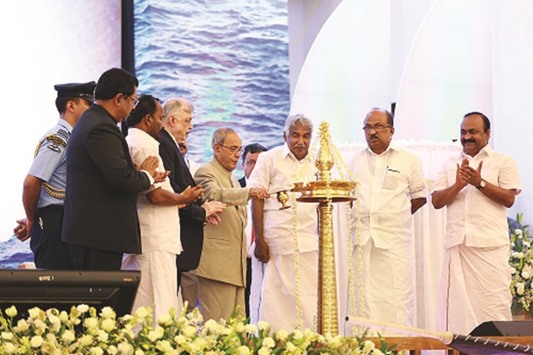President Pranab Mukherjee yesterday inaugurated Kerala’s new tourism project, a mammoth conservation undertaking based on archaeological findings on the ancient spice route linking India with contemporary ancient civilisations.
The Muziris Heritage Project aims at reviving a three-millennia-old cultural and civilizational heritage that brought the Arabs, Europeans and the Chinese traders to the Kerala coasts in search of spices.
The president said the project should spread the message of Indian cosmopolitanism far and wide adding to the country’s soft power across the world.
“Kerala has through the ages demonstrated a remarkable ability to adapt to new traditions and values in every sphere of human thought and endeavour,” he said.
The project is an effort to conserve and showcase a culture that had existed for over 3000 years when Kerala had established itself as a major centre of spice trade with the ancient port of Muziris as its hub.
However, historians like MGS Narayanan dispute the claims about its exact site.
“This town and its surroundings have been a thriving centre of Islam, Christianity, Judaism as well as Hinduism,” the Mukherjee said.
“Kodungallur is also believed to be the place where the Apostle of Jesus Christ, St Thomas, landed bringing with him Christianity to India much before it reached Europe.”
The project, initiated six years ago, comprises the development works of palaces, Cheraman, synagogues, a performance centre and museum.
It also envisages the conservation of archaeological monuments within 125 square kilometres spread across Thrissur and Ernakulam districts, including Cheraman Masjid, believed to be India’s first mosque.
Muziris finds mention in the Voyage around the Erythraean Sea, a work by a Greek-speaking Egyptian merchant from the middle of the first century CE, described as one of the four active ports which exported pepper and other goods.
Pliny the Elder, a Roman naturalist of the first century CE, refers to Muziris, in his encyclopaedic work, Naturalis Historia, as ‘the first emporium’ of India, a place reserved for the business interests of foreign traders.
It is believed that a devastating flood that changed the course of the Periyar river or an earthquake in the 14th century led to its decline.
But, the Malabar coast remained a prime destination for foreign traders and visitors, including Ibn Battuta and Marco Polo, who wrote extensively about it.
The Arabs continued their flourishing trade in spices and the Chinese were frequent visitors.
“The kings gifted land to set up places of worship and offered protection and patronage to believers of different religions,” he said.
“Today, Kerala is a state where religions share traditions. Many churches light oil lamps and raise flags as is done in Hindu temples. Similarly, the Cheraman Mosque has an oil lamp which is always lit.”
This is the largest conservation project in India and the first green project in Kerala. The next phase is supported by the Unesco and UN World Tourism Organization.
The initiative links 41 countries in Asia and Europe with India, where Kerala’s pepper, precious stones, silk, beads, ivory and pottery reached, in exchange for gold coins, glass, wine and wheat.
This initiative aims to revive cultural and academic exchange between these nations for the development of a multi-national cultural corridor.
Mukherjee also released a coffee table book on the Spice Route, which in first-ever by a tourism board is available on Kindle.
Chief Minister Oommen Chandy said the project, implemented with active federal support, would define the state’s tradition of accepting and absorbing other cultures from around the world.
Tourism Minister A P Anil Kumar said it would open doors to the immense opportunities in educational tourism, a growing industry across the world.
After a lot of research, excavation works and consistent efforts to restore a lost heritage, the state has planned to open 29 museums. A hop-on-hop-off boat tour of the Muziris Museums has also been developed as a unique way to experience this remarkable heritage.
Recently, the Parliamentary Standing Committee on Transport, Tourism and Culture had applauded the Kerala government’s initiative, saying it will not only revive India’s glorious heritage as a destination for travellers and traders but would also give a larger foothold for garnering world tourism revenue.
India is also keen on the idea of promoting the ancient Sea Route used for trade and commerce.

President Pranab Mukherjee lights the traditional lamp at the launch of Kerala Tourism’s Muziris Heritage Project as (from left) state chief secretary Jiji Thomson, MLA T N Prathapan, Governor Justice P Sathasivam, Chief Minister Oommen Chandy, MP K V Thomas and MLA V D Satheesan look on.


